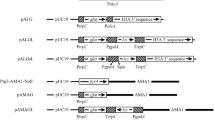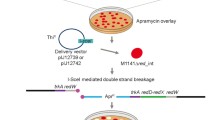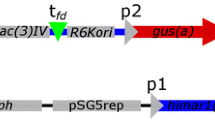Abstract
Single-read sequence analysis of the termini of eight randomly picked clones ofAshbya gossypii genomic DNA revealed seven sequences with homology toSaccharomyces cerevisiae genes (15% to 69% on the amino acid level). One of these sequences appeared to code for the carboxy-terminus of threonine synthase, the product of theS. cerevisiae THR4 gene (52.4% identity over 82 amino acids). We cloned and sequenced the complete putativeAgTHR4 gene ofA. gossypii. It comprises 512 codons, two less than theS. cerevisiae THR4 gene. Overall identity at the amino acid sequence level is 67.4%. A continuous stretch of 32 amino acids displaying complete identity between these two fungal threonine synthases presumably contains the pyridoxal phosphate attachment site. Disruption of theA. gossypii gene led to threonine auxotrophy, which could be complemented by transformation with replicating plasmids carrying theAgTHR4 gene and variousS. cerevisiae ARS elements. Using these plasmids only very weak complementation of aS. cerevisiae thr4 mutation was observed. Investigation of sequences adjacent to theAgTHR4 gene identified three additional ORFs. Surprisingly, the order and orientation of these four ORFs is conserved inA. gossypii andS. cerevisiae.
Similar content being viewed by others
References
Aas SF, Rognes SE (1990) Nucleotide sequence of the yeastTHR4 gene encoding threonine synthase. Nucleic Acids Res 18:665
Alting-Mees MA, Short JM (1989) II: gene mapping vectors. Nucleic Acids Res 17:9494
Ashby SF, Nowell W (1926) The fungi of stigmatomycosis. Ann Botany 40:69–84
Bacher A, Van QL, Keller PJ, Floss HG (1983) Biosynthesis of riboflavin. Incorporation of13C labeled precursors into the xylene ring. Proc Natl Acad Sci USA 258:13431–13437
Broach JR, Volkert FC (1991) Circular DNA plasmids of yeasts. In Broach JR, Pringle JR, Jones EW (eds) The molecular and cellular biology of the yeastSaccharomyces, vol 1. Cold Spring Harbor Laboratory Press, Cold Spring Harbor, pp 297–332
Bullock WO, Fernandez JM, Short JM (1987) XL1-blue: a high efficiency plasmid-transformingrecA Escherichia coli strain with beta-galactosidase selection. BioTechniques 5:376–378
Clepet C, Borne F, Krishnapillai V, Baird C, Patte JC, Cami B (1992) Isolation, organization and expression of thePseudomonas aeruginosa threonine genes. Mol Microbiol 6:3109–3119
Demain AL (1972) Riboflavin oversynthesis. Annu Rev Microbiol 26:369–388
Gaudenz K (1994) The small genome of the filamentous fungusAshbya gossypii: assessment of the karyotype. Diploma Thesis, Biozentrum, University of Basel, Switzerland
Goffeau A (1994) Genes in search of functions. Nature 369:101–102
Han KS, Archer JA, Sinskey AJ (1990) The molecular structure of theCorynebacterium glutamicum threonine synthase gene. Mol Microbiol 4:1693–1702
Hawthorne DC, Mortimer RK (1960) Chromosome mapping inSaccharomyces: centromere-linked genes. Genetics 45:1085–1110
Hinnebusch AG (1992) General and pathway-specific regulatory mechanisms controlling the synthesis of amino acid biosynthetic enzymes inSaccharomyces cerevisiae. In: Jones EW, Pringle JR, Broach JR (eds) The molecular and cellular biology of the yeastSaccharomyces, vol 2. Cold Spring Harbor Laboratory Press, Cold Spring Harbor, pp 319–414
Ito H, Fukuda Y, Murata K, Kimura A (1983) Transformation of intact yeast cells with alkali cations. J Bacteriol 153:163–168
Jandrositz A, Turnowsky F, Hogenauer G (1991) The gene encoding squalene epoxidase fromSaccharomyces cerevisiae: cloning and characterization. Gene 107:155–160
Kataoka T, Broek D, Wigler M (1985) DNA sequence and characterization of theSaccharomyces cerevisiae gene encoding adenylate cyclase. Cell 43:495–505
Keller PJ, Van QL, Kim SU, Born DH, Chen H, Kohnle A, Bacher A, Floss HG (1988) Biosynthesis of riboflavin: mechanism of formation of the ribitylamino linkage. Biochemistry 27:1117–1120
Malumbres M, Mateos LM, Guerrero C, Martin JF (1988) Nucleotide sequence of the threonine synthase (thrC) gene ofBrevibacterium lactofermentum. Nuclic Acids Res 16:9859
Malumbres M, Mateos LM, Guerrero C, Martin JF (1995) EMBL data bank, AC Z29562, X12797
Mohr C (1995) Genetic engineering of the filamentous fungusAshba gossypii: construction of a genomic library, isolation of genes for-beta-isopropylmalate-dehydrogenase (LEU2) and a protein kinase (APK1) by heterologous complementation, and characterization of non-reverting mutants. PhD Thesis, Biozentrum, University of Basel, Switzerland
Motoyama H, Maki K, Anazawa H, Ishino S, Teshiba S (1994) Cloning and nucleotide sequences of the homoserine dehydrogenase genes (hom) and the threonine synthase genes (thrC) of the gram-negative obligate methylotrophMethylobacillus glycogenes. Appl Environ Microbiol 60:111–119
Oka A, Sugisaki H, Takanami M (1981) Nucleotide sequence of the kanamycin-resistance transposon Tn903. J Mol Biol 147:217–226
Oliver SG, van der Aart Q, Agostoni CM, Aigle M, Alberghina L, Alexandraki D, Antoine G, Anwar R, Ballesta JP, Benit P et al. (1992) The complete DNA sequence of yeast chromosome III. Nature 357:38–46
Omori K, Suzuki S, Komatsubra S (1991) Analysis of thethrA1A2BC Serratia marcescens Sr41. EMBL data bank, AC X60821
Parsot C (1986) Evolution of biosynthetic pathways: a common ancestor for threonine synthase, threonine dehydratase and Dserine dehydratase. EMBO J 5:3013–3019
Parsot C, Cossart P, Saint-Girons I, Cohen GN (1983) Nucleotide sequence ofthrC and of the transcription termination region of the threonine operon inEscherichia coli K12. Nucleic Acids Res 11:7331–7345
Ramos C, Calderon IL (1994) Biochemical evidence that theSaccharomyces cerevisiae THR4 gene encodes threonine synthetase. FEBS Lett 351:357–359
Rothstein RJ (1983) One-step gene disruption in yeast. Methods Enzymol 101:202–211
Sambrook J, Fritsch EF, Maniatis T (1989) Molecular cloning: a laboratory manual (2nd edn). Cold Spring Harbor Laboratory Press, Cold Spring Harbor, New York
Shaafatian R, Payton MA, Reid JD (1994)PWP2, an essential gene ofSaccharomyces cerevisiae with homology to beta-transducin is required for bud-site selection and cell separation. EMBL data bank, AC X78964
Sherman F, Fink GR, Hicks JB (1987) Methods in yeast genetics. Cold Spring Harbor Laboratory Press, Cold Spring Harbor, New York
Sikorski RS, Hieter P (1989) A system of shuttle vectors and yeast host strains designed for efficient manipulation of DNA inSaccharomyces cerevisiae. Genetics 122:19–27
Steiner S (1991) Expressionsstudien im filamentösen PilzAshbya gossypii unter Verwendung von Signalsequenzen desTEF-Gens. PhD Thesis, Justus Liebig Universität Giessen, Germany
Steiner S, Philippsen P (1994) Sequence and promoter analysis of the highly expressedTEF gene of the filamentous fungusAshbya gossypii. Mol Gen Genet 242:263–271
Steiner S, Wendland J, Wright M, Philippsen P (1995) Homologous recombination as the main mechanism for DNA integration and cause of rearrangements in the filamentous ascomyceteAshbya gossypii. Genetics 140:973–987
Thierry A, Fairhead C, Dujon B (1990) The complete sequence of the 8.2 kb segment left ofMAT on chromosome III reveals five ORFs, including a gene for a yeast ribokinase. Yeast 6:521–534
Wickerham LJ, Flickinger MH, Johnston RM (1946) The production of riboflavin byAshbya gossypii. Arch Biochem 9:95–98
Wright M, Philippsen P (1991) Replicative transformation of the filamentous fungusAshbya gossypii with plasmids containingSaccharomyces cerevisiae ARS elements. Gene 109:9–105
Yanisch-Perron C, Vieira J, Messing J (1985) Improved M13 phage cloning vectors and host strains: nucleotide sequence of the M13mp18 and pUC19 vectors. Gene 33:103–119
Zaret KS, Sherman F (1982) DNA sequence required for efficient transcription termination in yeast. Cell 28:563–573
Author information
Authors and Affiliations
Additional information
Communicated by C. P. Hollenberg
Rights and permissions
About this article
Cite this article
Altmann-Jöhl, R., Philippsen, P. AgTHR4, a new selection marker for transformation of the filamentous fungusAshbya gossypii, maps in a four-gene cluster that is conserved betweenA. gossypii andSaccharomyces cerevisiae . Molec. Gen. Genet. 250, 69–80 (1996). https://doi.org/10.1007/BF02191826
Received:
Accepted:
Issue Date:
DOI: https://doi.org/10.1007/BF02191826




